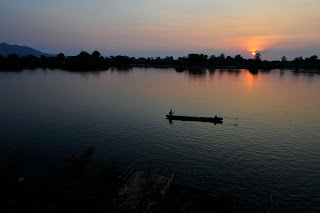
Tragedy in history always hits the nicest people. Come to Cambodia, and you'll find it hard to disagree. Wherever you walked you'll be accompanied by smiles; gappy, toothless and flawless. But you'll also notice the abuidance of youngsters, and the paucity of people above the age of 40, generations missing. Those familiar with history will know why. For those who aren't, I will use this blogpost to introduce you to the Khmer Rouge and the Cambodian genocide.

Timeframe: the early Seventies. China has just taken the Great Leap Forward, Vietnam is slowly defeating the USA. The Cold War is at its highest; Communism seems like a viable option. In Cambodia, Prince Sihanouk has been deposed and a uber-corrupt republic is in place. In the meanwhile, American bombings in Vietnam have extended beyond the Cambodian border. A group of Cambodian intellectuals, who have spent years studying in Paris some 20 years previusly, have become fascinated by Marx and Engels' writings. Back to Cambodia, they form the Khmer Rouge, a political-military group fighting the Republican Army. They finally succeed, Phnom Penh falls on April 17th, 1975. The horrors begin.
Cities are emptied, money and banks are abolished, families are separated, everybody has to wear black. Religion is abolished, monks are forced to disrobe or killed. Colours cease to exist, alongside any remnants of personal liberty. The goal of the new regime is to create a self-sufficient agrarian society. Everybody is relocated to the countryside, to grow rice. People with skills are considered potential enemies, and are quickly eliminated. Their children are also killed, to prevent the possibility of revenge. Others, children included, are forced to work up to 18 hours a day. However, lack of agricultural knowledge of most relocated people and the impossible goals set up by the party cause famine, disease and death. The rice produced is used to pay debts, especially with China and Korea, leaving people with only a few ounces a day. Because of the party's goals of self-sufficiency, there are no medicines or hospitals. Most doctors and nurses are killed because of their education. In only a few months, Cambodia has reached its darkest time.

After three years, 8 months and 20 days, the regime ended. Between 1.5 and 2 million Cambodians died, either killed by the Khmer Rouge or succumbed to starvation or disease. What is left is a broken country. Phnom Penh still bears the scars of these horrors. Tuol Sleng, a former high school converted into prison, is now a museum to the genocide. Nearly 20,000 people were imprisoned at Tuol Sleng, known as S-21 prison. Only 7 survived. We visited the museum, which still hosts the cells used to confine the captives. We saw the mugshots of prisoners; children and babies could also be identified as 'enemies of the country'. The atmosphere was dark, thick, I felt almost breathless. I could sense the suffering, the screaming and the despair that went on behind these walls. Then we headed to the Killing Fields. Thousands of people were killed, shot in the first part of the war, then clubbed with hoes, sitcks or other implements. Babies were swung on a tree until their skulls smashed. The Khmer Rouge did not even gave these people a quick, painful death by a bullet. Wandering around the mass graves, fragments of bone, cloth and teeth poke through the ground. The tragedy suddenly felt tangible, beyond real.

Now, fast-forward 30 years. Cambodia's economy and cities are still being rebuilt. This is a counrty who has witnessed some of the most atrocious occurrences of the 20th century. Still, the smiles accompany you wherever you go. Please, my dear reader, I beg you, if you visit Cambodia do not hide behind a blanket of ignorance. Don't be marvelled by the Temples of Angkor without visiting Tuol Sleng prison and the Killimg Fields. History cannot be undone, don't pretend it hasn't happened. The fallen deserve to be remebered.





































